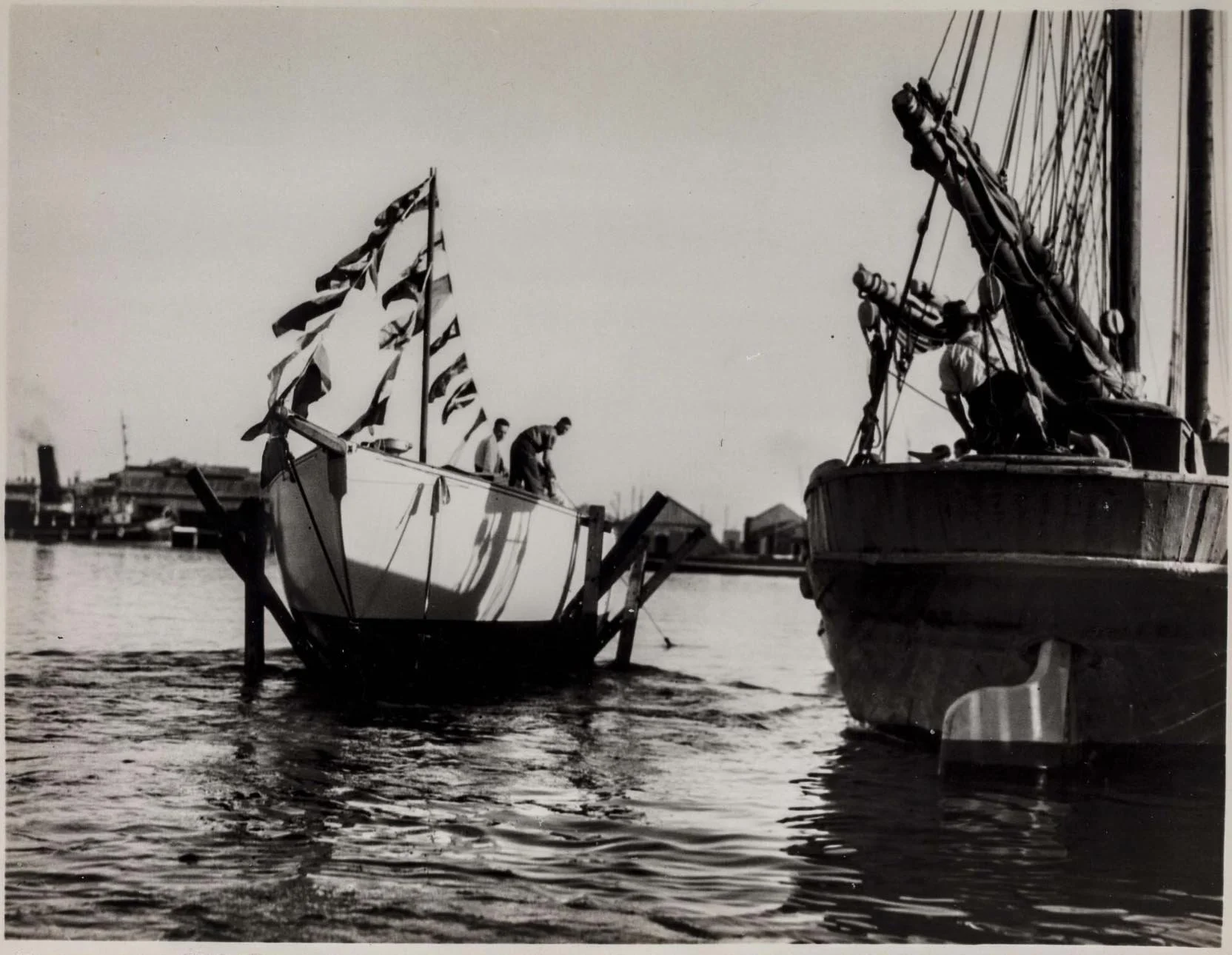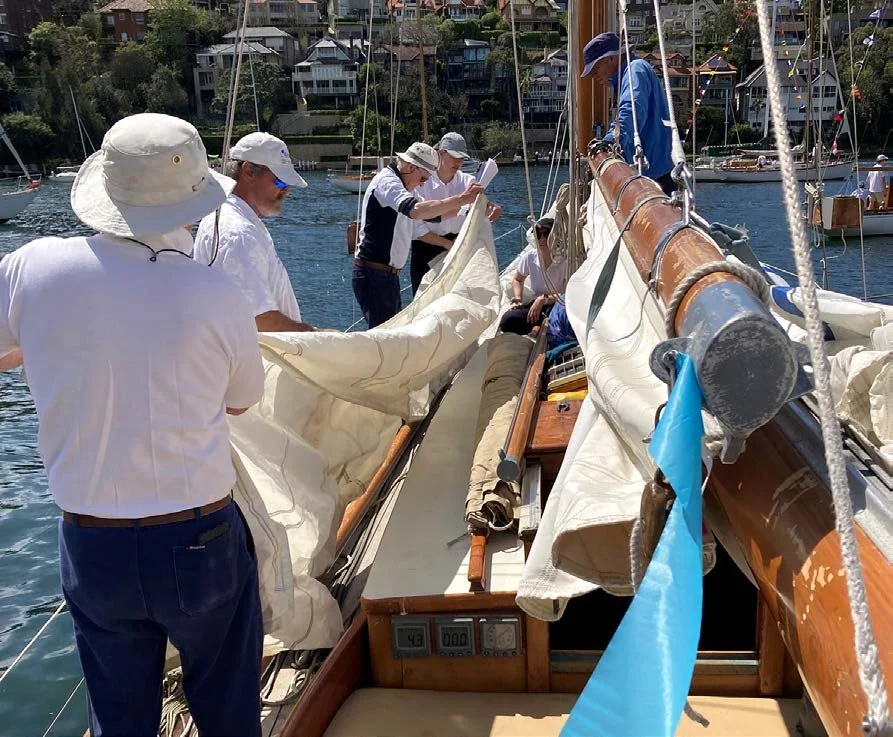Gaffers Day on NERIDA
David Salter provides this deck-eye view from Sir James Hardy’s legendary gaff cutter. Thanks to the SASC for letting us share this story.
NERIDA’s launch 1933
There are quite a few strings to pull if you want to race Nerida with all guns blazing. At the mast are halyards for the gaff peak and gaff jaws (both with their separate tackles), the jib, the staysail, the jib topsail, the jackyard and the spinnaker. Raising the jackyard topsail requires the addition of another two halyards.
On deck we find sheets for the jib and staysail (each also with their own tackles), plus the all-important runners. Each is made off on traditional wooden cleats. The mainsheet trimming the 30-foot boom is double-ended but the blocks offer only a 3-to-1 advantage. There are no winches except for two that have been installed recently to help raise the gaff. Everything else — a total of 22 lines — is man-hauled (sorry, person hauled). And just to keep things interesting, every one of those lines is white. There’s none of this “just pull the blue one” stuff. To sail NERIDA properly requires an understanding of how gaff rigs work, and which lines do what tasks. The boat itself is substantial. She’s 45 feet LOA plus 8 feet of bowsprit and displaces 16 tons.
Every classic yacht should have her decks scrubbed before sailing-Photo John Jeremy
The forces at play once the five working sails all fill are huge and mistakes can be very costly. December 2022 Since her first Gaffers Day back in the early 1980s the yacht has always sailed under the command of her owner, Sir James Hardy OBE. But, regrettably, ‘Gilbert’ was unable to take the helm this year and nominated me to skipper the boat in his place. The awesome responsibilities of high office! I was fortunate that almost all of the MISTER CHRISTIAN regulars and friends were happy to sign on. To that scurvy crew were added the esteemed sailing coach, Neville Witty, and two of his outstanding young women sailors from the RSYS training program. I would not be short of talent, strength or ability. But not one of them had any experience sailing a gaff-rigged yacht of this size. ‘Not to worry,’ I thought. ‘They’re all good, smart sailors. They’ll pick it up as we go along.’ Which indeed they did. Most things only have to be explained or demonstrated once to people with a natural instinct for yachts and yachting. But there’s always an exception. In the case of Nerida that snag is the method for rigging the jackyard topsail — the inverted triangle of sail set on two light spars which fits high up in the space between the gaff and the topmast.
Preparing the jackyard topsail for hoist on Nerida-Photo Jim Nixon
The process of rigging and hoisting this sail is complex and Sir James December 2022 normally oversees the arcane jackyard ritual in person. But, knowing he’d be absent, he provided us with detailed written instructions in the form of two closely typed pages of step-by-step words, plus another two pages of diagrams. How could we go wrong?
Sir James Hardy’s detailed instructions
One of the difficulties is that the jackyard sail first has to be fitted to its spars on deck and is then only hoist into position after the huge gaff main has been raised. Everything needs to be rigged and ready so that with the boat close-hauled on port tack the whole contraption can be hauled up on two temporary halyards and a downhaul tack line (inside the running backstay but outside the checkstays), and dropped into place. It is to the great credit of our debut crew that they managed this challenging feat at the first attempt. After effusive self-congratulations and a restorative glass of bubbly we sauntered towards the start in Athol Bight. With her substantial displacement, complex sail plan, hand-hauled runners and long straight keel Nerida is somewhat less than nimble. She takes around 20 seconds just to tack. Strategy needs to be decided well in advance.
Heavy spars and sails require plenty of halyard manpower -Photo David Salter
Neville assumed the role of Honorary Tactician and provided a steady stream of instructions and advice. Initially, many of his calls seemed more appropriate for an Etchells than a 90-year-old Alfred Mylne cutter but he soon adapted to our rather stately mode of progress.
The 1932 Alfred Mylne design still cuts a neat track-Photo David Salter
I certainly appreciated having a knowledgeable set of eyes and ears posted beside the mast. Helming a big heavy boat by tiller is a full-time physical job, and visibility from the cockpit is limited.
Tiller steering on a 16-ton yacht demands both hands on the job Photo Jim Nixon
Neville and our bowman (more accurately bowsprit man), Jim Nixon, came up with a clever idea that had never occurred to me during more than 40 years of sailing on NERIDA. They suspected that the flying jib (jib topsail) might actually slow us down sailing to windward and suggested we just furl and lash it to the whisker stays uphill and then raise it for the reaching and running legs. They were right. Even Sir James, who was watching our every move through binoculars from his apartment at Potts Point, was impressed. Which just goes to show: you can teach an old sea-dog new tricks.
Nerida shadowed by the Channel Nine helicopter -Photo John Jeremy
Completing the race without incident was immensely satisfying. But the December 2022 true spirit of Gaffers Day only comes to the fore when everyone returns to the Amateurs. The seductive aroma of BBQ sausages drifts across Mosman Bay. Approaching from a distance we could already hear the laughter and merry clink of glasses.
Can there be a more-friendly bunch of people than the Sydney classic yacht community?








